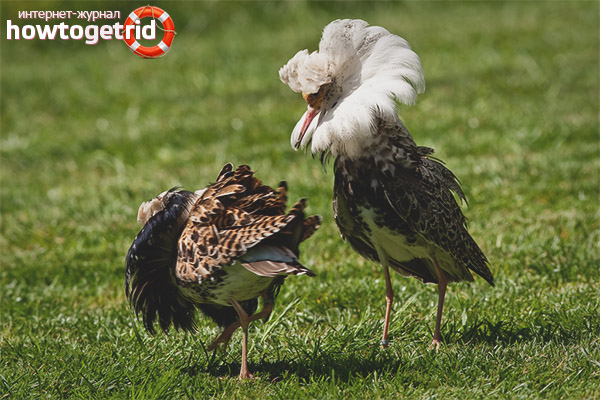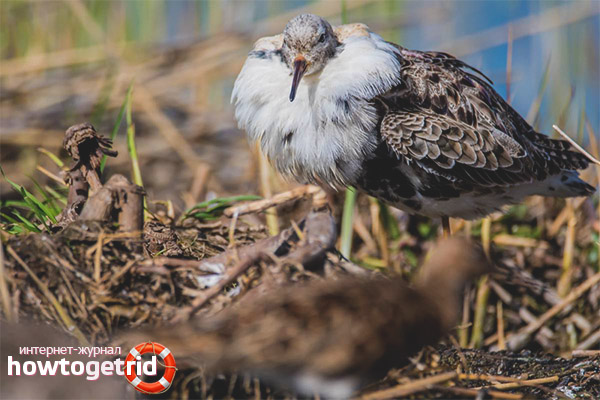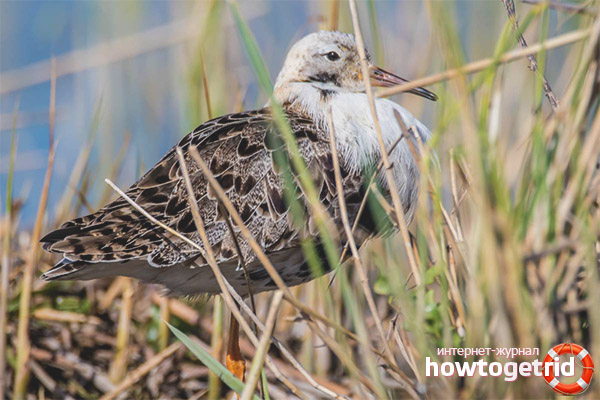The content of the article
Turukhtan males during the mating season have a very attractive appearance. But they attract females not only for their bright appearance. They perform beautiful dances, fight among themselves, in this way trying to attract attention and take a certain place in the hierarchy. After all, they are forced to conquer the female every year, since the species belongs to polygamous.
general description
The body length of the male is about 26-29 cm, while the female is on average 5 cm less. The mass of the male is about 125-225 g, the females weigh from 75 to 145 g. Puberty in turukhtans begins at the age of 1-2 years.
Nesting occurs between May and August. The female lays about 4 eggs at a time. The hatching period lasts about 3 weeks.
Turukhtan is a flock of birds, active in the daytime, polygamous in nature. Various mollusks, insects, and also plant seeds serve as food for them. These birds live for about 11 years.
Appearance
The head is small. The beak is short, slightly bent down.
The eggs of these birds have a greenish tint; they are studded with small black and greenish spots.
The female does not change color throughout the year. She is motley, grayish brown.
Habitat
These birds live in Siberia, as well as in northern Europe. They spend the winter in Africa, south of the Sahara desert. This area is very far from nesting sites. Therefore, during migration, birds have to travel a great distance. During flights, they stop to rest near ponds.
Nutrition
Turukhtans usually hunt at night. They walk along the shores of various bodies of water in search of small aquatic animals. With the help of their beak, they seek food in the silt, can also walk in shallow water or swim. During the nesting period, females feed on land. Here they catch various insects. In the remaining months, their diet may also include various plants. Their favorite treats are snail worms, as well as plant seeds.
Flights

Most representatives of the winter view fly to Africa. Their wintering sites are located south of the Sahara. In the fall over the countries of central Europe you can see a flock of turukhtans. Males arrive at the nesting site in March, while females - a month later. When the nesting period ends, males first fly away. This happens by the end of June. Females with offspring fly away only after a month.
Lifestyle
In the spring, males gather in groups near ponds to begin their ritual fights. Each male has a place on the livestock; he runs on the ground and tramples on the grass.The bird sets its head forward, raises its plumage, flaps its wings. Turukhtans know how to crawl, they cling to the ground with their beak, and then they pull themselves up. Mating often ends in a fight between males, they begin to peck at each other, and also scratch with claws. But they do not cause severe injuries to each other.
During mating, males are strictly in their places. Young individuals stand at the edge of the currents. Older individuals are located closer to its center. A young male can take a seat closer to the center only after he wins the fight against an older male.
Breeding
As mentioned above, these birds are polygamous. Males, which occupy a more advantageous place in the hierarchy, are able to mate with several females in one breeding season. Females fly from one current to another in order to find a suitable partner for themselves. When a partner is selected, the female begins to fumble on the collar of the male. After mating, it immediately flies away. On this their communication ends.
After that, she herself builds a nest, hatches eggs, and also takes care of the offspring without the participation of a male. This feature is a distinctive feature of the species from other birds that belong to the snipe family. Its other representatives take care of the offspring together.
These birds build their nests in reeds. They are located at a distance of half a kilometer from the current. They make a small depression, covering it with grass, algae, well hiding the nest in the thickets. Female Turukhtan lays eggs in the second half of May or early June. The hatching period lasts about 3 weeks, after which the chicks appear. They leave the nest as soon as they hatch. Their fluff has a protective color. The female finds food for them for several days, after which they begin an independent life.
Observations

You can also meet these birds in the northern part of France. This area is located much further south than their usual habitat. Previously, they nested in Ukraine. In mid-March, they fly to the territory of Crimea to their nesting sites. They return to Estonia only at the end of April. During flights, birds stop to rest, choosing meadows or plains, near which there are ponds. Their favorite place is swamps. By the period of migration, the male loses his mating plumage. During the flight, these birds can also be found in Russia.
Interesting Facts
- These birds travel great distances. Individuals nesting in Siberia fly away to a distance of 15,000 km each year to get to the wintering site.
- For several decades, turukhtans have not nested in some regions in which they lived before. They left the Austrian lake Neusiedler See. In addition, they left Ukraine and Hungary. To date, these birds can be seen only in the southern part of their usual range. It is interesting that at the beginning of the last century, the turukhtans completely left the territory of Great Britain. But in the 60s they began to nest there again.
- In English, the name of the females and the name of the males sounds differently. The name of the females translates as "ruff". In French, the name of the bird sounds like “a knight beats.”
Protection and security
Over the past decades, there has been a significant reduction in the number of turukhtans worldwide. This is due to human activities. Familiar habitats are destroyed, swamps are drained. Several hundred individuals nest today in northern Germany.
Video: turukhtan (Philomachus pugnax)










Submit